Adding microgreens to your daily meals adds flavor and texture, making eating healthy fun!
Microgreens are convenient, with little to no prep necessary. This makes it easy to create beautiful dishes that everyone will enjoy.
Many varieties can be purchased at local stores, see home page for a list.
Pricing for chefs and produce managers can be requested through the Contact Page.
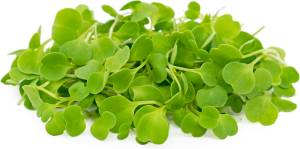
Arugula
That classic arugula bite with fresh, buttery tones. A favorite for salad additions, soup and pasta toppings!
- Vitamins A and C, calcium, iron, and phosphorus
- 2 week cultivation time.
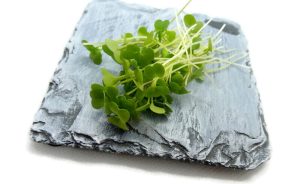
Broccoli
The most popular single microgreen!
Small, tender leaves with a pale stem and fresh taste.
- The healthiest of all microgreens! A mild addition to smoothies.
Vitamins A, B, C, potassium, and the phyto-chemicals sulforophane indole and isothiocyanate. Research suggests that these phytochemicals may reduce the risk of multiple forms of cancer. - 2 week cultivation time.
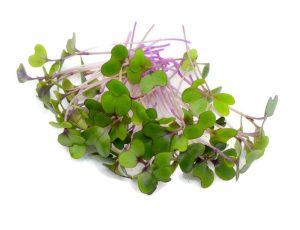
Cabbage, Red
Full brassica flavor, dark green leaves with violet to red highlights throughout. Purple stems. A soft and fresh microgreen with a mild pleasant flavor and striking color.
- High in Vitamins C, A, and E, beta-carotenes, potassium and iron.
- 2 week cultivation time.
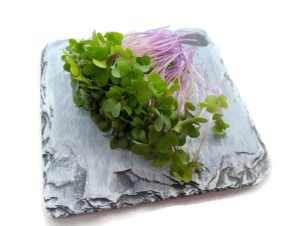
Kohlrabi, Purple
Beautiful pink stems make a great base for any microgreens salad. The interesting color combinations make them great garnishes or additions to any sandwich or slaw. Lighter green leaves with more varied color than red cabbage. Has a great broccoli and cabbage flavor.
- Full of antioxidants, fiber, Vitamins A,C, and B-complex, calcium, potassium and copper
- 2 week cultivation time.
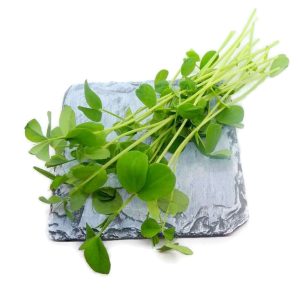
Pea Shoots, Speckled
Fresh, sweet pea taste with large green leaves with delicate tendrils to add flavor and interest to any dish. Longer and more tender than Tendril Pea.
- High in chlorophyll, protein, enzymes, and minerals.
- 2 week cultivation time.
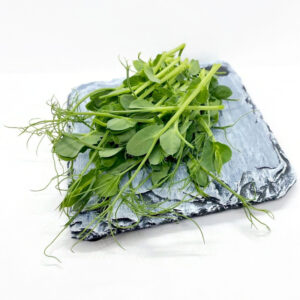
Pea Shoots, Tendril
Mild pea flavor with tender green leaves and lots of tendrils to add texture and heft to any dish. Shorter, more fibrous, with more tendrils than Speckled Pea.
- High in chlorophyll, protein, enzymes, and minerals.
- Approx. 100 pc per oz
- 2 week cultivation time.
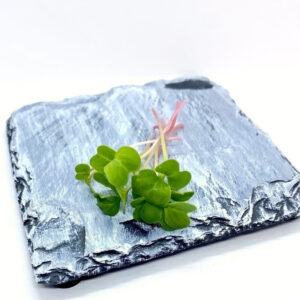
China Rose Radish
China Rose: rosy stems… Fresh and spicy, a great addition to any salad or sandwich.
This is also found in the radish mix, along with Daikon and Rambo.
- 2 week cultivation time.

Daikon Radish
Daikon: green leaves with bright white stems… Fresh and spicy, a great addition to any salad or sandwich.
This is also found in the radish mix, along with Chin Rose and Rambo.
- 2 week cultivation time.
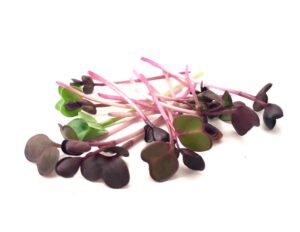
Rambo Red Radish
Red Rambo: Beautiful, dark purple leaves and richly colored stems… Fresh and spicy, a great addition to any salad or sandwich.
This is also found in the radish mix, along with China Rose and Daikon.
- 2 week cultivation time.
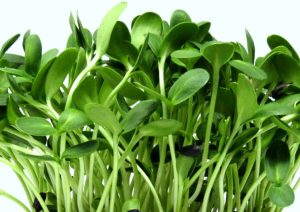
Sunflower Shoots
Hefty sprouts with juicy stems and nutty flavor. A definite favorite with kids!
- Comprised of 24% to 30% protein
- High in fiber, essential fatty acids, vitamins A, B complex, C, D, and E. Calcium, phosphorous, iron, iodine, potassium, magnesium, zinc, manganese, copper, and chromium.
- 2 week cultivation time.
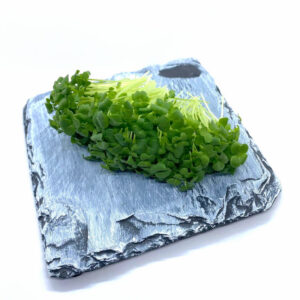
Wasabi Mustard
Stout, succulent micros with that distinctive Japanese Wasabi flavor. Ideal for sushi, ramen or any dish needing a sharp bite of heat.
- Mustard microgreens contain high levels of antioxidants, are high in fiber, and can help detoxify your liver and blood.
- 2 week cultivation time.
HIGH IN NUTRIENTS
Contain 4-40 times more nutrient density by weight than their fully-grown counterpart.
IMPROVE HEART HEALTH
Studies have shown microgreens may help reduce heart disease risk factors, such as weight, bad LDI, cholesterol & triglycerides.
CONTAIN POLYPHENOLS
Prevent the buildup of harmful free radicals associated with a reduced risk of heart disease, cancer and Alzheimer’s disease. Contain wider variety of polyphenols than their mature vegetable counterparts.
REDUCE CHRONIC DISEASE RISK
Veggie consumption is associated with the lower risk of certain cancers, inflammation, heart disease, diabetes & obesity. (Sources: NCBI, FASEB)
